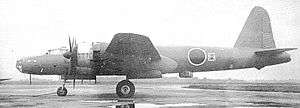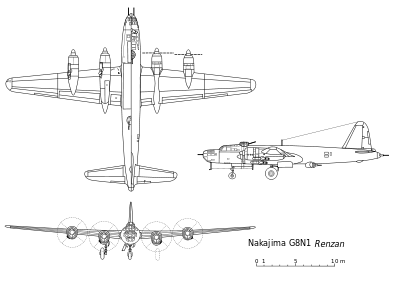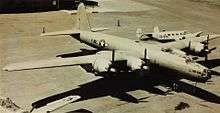Nakajima G8N
| G8N Renzan | |
|---|---|
 | |
| Role | Heavy bomber |
| Manufacturer | Nakajima Aircraft Company |
| First flight | 23. October 1944 |
| Retired | 1945 |
| Primary user | IJN Air Service |
| Produced | 4 |
|
| |
The Nakajima G8N Renzan (連山, "Mountain Range") was a four-engine long-range bomber designed for use by the Imperial Japanese Navy. The Navy designation was "Type 18 land-based attack aircraft" (十八試陸上攻撃機); the Allied code name was "Rita".
Design and development
In February 1943 the Imperial Navy staff asked Nakajima Aircraft Company to design a four-engined bomber, capable of meeting an earlier specification set for a long-range land-based attack plane. The final specification, issued on 14 September 1943, called for a plane with a maximum speed of 320 knots (590 km/h; 370 mph) able to carry a 4,000 kg (8,800 lb) bomb-load 2,000 nmi (3,700 km; 2,300 mi) or a reduced bomb-load 4,000 nmi (7,400 km; 4,600 mi).[1]
Nakajima's design featured a mid-mounted wing of small area and high aspect ratio, a tricycle landing gear and a large single-fin rudder. Power came from four 2,000 hp Nakajima NK9K-L "Homare" 24 radial engines with Hitachi 92 turbosuperchargers driving four-bladed propellers. The engines were cooled by counter-rotating fans positioned just inside the engine cowlings.[1] Defensive armament included power-operated nose, dorsal, ventral and tail turrets along with two free-swiveling machine guns at the beam positions.[2]
Operational history
The initial prototype was completed in October 1944 and delivered to the Navy for testing in January 1945, a year after the Navy ordered development to start. Three further examples were completed by June 1945, with the third prototype being destroyed on the ground by US carrier aircraft.[2]
Other than minor problems with the turbosuperchargers, the Renzan performed satisfactorily and the Navy hoped to have a total of 16 prototypes and 48 production-version G8N1s assembled by September 1945. But the worsening war situation and a critical shortage of light aluminium alloys led to the project's cancellation in June.[2]
One proposed variant was the G8N2 Renzan-Kai Model 22, powered by four 2,200 hp Mitsubishi MK9A radial engines and modified to accept attachment of the air-launched Ohka Type 33 Special Attack Bomber.[2]
Just prior to Japan's surrender in August 1945 consideration was also briefly given to producing an all-steel version of the aircraft, to be designated G8N3 Renzan-Kai Model 23, but the cessation of hostilities precluded any further development.[2]
After the war, one prototype was taken to the United States[3][4] and scrapped after testing. None are in existence today.
Variants
- G8N1 : Four-engine heavy bomber. Production version.
- G8N2 : Modified to carry Ohka Type 33 Special Attack Bomber. Four Mitsubishi MK9A radial engines.
- G8N3 : All-steel airframe.
Operators
Specifications (G8N1)

Data from Japanese Aircraft of the Pacific War[2]
General characteristics
- Crew: ten
- Length: 22.94 m (75 ft 3 in)
- Wingspan: 32.54 m (106 ft 9 in)
- Height: 7.20 m (23 ft 7 in)
- Wing area: 112 m² (1,205 ft²)
- Empty weight: 17,400 kg (38,400 lb)
- Loaded weight: 26,800 kg (59,100 lb)
- Max. takeoff weight: 32,150 kg (70,900 lb)
- Powerplant: 4 × Nakajima NK9K-L Homare 24 18-cylinder radial engines, 1,491 kW (2,000 hp) each
Performance
- Maximum speed: 576 km/h (358 mph)
- Range: 7,250 km (4,500 miles)
- Service ceiling: 10,200 m (33,500 ft)
- Rate of climb: 457 m/min (1,500 ft/min)
- Wing loading: 239 kg/m² (49 lb/ft²)
- Power/mass: 0.22 kW/kg (0.14 hp/lb)
Armament
- 2× 20 mm Type 99 cannon in each dorsal, ventral, and tail turrets
- 2× 13 mm (.51 in) Type 2 machine guns in nose turret
- 2× 13 mm (.51 in) Type 2 machine gun in fuselage sides
- Up to 4,000 kg (8,818 lb) of bombs
See also
| Wikimedia Commons has media related to Nakajima G8N Renzan. |
- Aircraft of comparable role, configuration and era
References
- Notes
- 1 2 Francillon, p. 440.
- 1 2 3 4 5 6 Francillon 1979, p. 441.
- ↑ Thorpe 1977, p. 27.
- ↑ A G8N "Rita" in the USA via http://www.ww2incolor.com
- Bibliography
- Collier, Basil. Japanese Aircraft of World War II. New York: Mayflower Books, 1979. ISBN 0-8317-5137-1.
- Francillon, Ph.D., René J. Japanese Aircraft of the Pacific War. London: Putnam & Company Ltd., 2nd edition 1979. ISBN 0-370-30251-6.
- Thorpe, Donald W. Japanese Naval Air Force Camouflage and Markings World War II. Fallbrook, California: Aero Publishers, Inc., 1977. ISBN 0-8168-6583-3. (hc.) ISBN 0-8168-6587-6 (pbk.)
- Unknown authors. Famous Airplanes of the World: Nakajima Shinzan / Renzan (Volume 11, no.146). Japan: Bunrin-Do, Nov. 1984.
| ||||||||||||||||||||||||||||||||||||||||||||||||||||||||||
| ||||||
| ||||||||||||||
